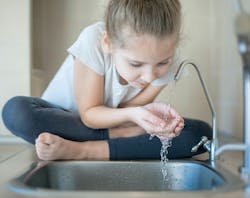The Difference Between Certification & Compliance
About the author:
Rick Andrew is director of Global Business Development for Water Systems at NSF International. Andrew can be reached at [email protected] or 734.913.5757.
Though they sound similar, there is an important difference between “certification” and “compliance.” When it comes to matters of public health, like the water we drink, these differences are critical.
We in the U.S. and Canada enjoy some of the safest drinking water in the world thanks to strict product standards.
Whether for pipes and plumbing fittings and components or drinking water treatment systems, standards are incredibly detailed and complex. Certification to these standards means the product is fit for purpose, at a minimum in terms of safety of materials in contact with drinking water, and often also in terms of mechanical or other performance aspects.
Simply put, certification means trust. It assures suppliers, retailers, regulators and consumers that an independent, accredited third-party certification body has thoroughly and carefully evaluated and tested a product against strict applicable standard criteria.
What is the Difference Between Certification & Compliance?
Compliance or “tested to” is a self-claim by a company that its product meets certain requirements of a standard or protocol. It may or may not be valid, or it may be partially valid.
For a product to be certified by an accredited certification body, it must meet all minimum requirements established in the standard not just a select few criteria.
Accredited, third-party certification includes extensive product testing to ensure that a product will perform as promised; analysis of formulation or product materials plus testing to verify that no harmful contaminants leach into the water; on-site audits of manufacturing facilities and ongoing surveillance to assure that products continue to meet high public health standards.
Nearly two dozen NSF/ANSI water standards or protocols cover water products, such as water treatment media, pipes, valves and other water distribution components, plumbing components, including plastic pipes and fittings, treatment chemicals and drinking water treatment units.
Any plumbing materials, from plastic or copper piping to fittings and valves, that come in contact with the water we drink conform to NSF/ANSI/CAN 61: Drinking Water System Components – Health Effects. This standard, required in 49 U.S. states and 11 Canadian provinces, sets leaching limits, based on peer-reviewed scientific data and toxicology studies on more than 2,000 chemical compounds. There is no higher level of confidence that products conform to the standard than accredited, third-party certification.
Standards addressing contaminant reduction claims for filtration systems or treatment devices cover a variety of contaminants, including the most common ones, such as lead, VOCs, arsenic, chromium, Cryptosporidium and a number of emerging contaminants such as PFOA, PFOS and microcystin.
How to Know If a Product is Certified
Most certified products bear the certifier’s mark on their packaging to help consumers and other buyers make educated purchasing decisions.
For example, certification language on packaging, product or marketing materials for NSF-certified products may include “NSF certified/NSF listed,” “Certified by NSF,” “Tested and certified by NSF,” “Tested and certified by NSF International” or “ABC company’s product is certified by NSF to NSF/ANSI #.” Similar language applies to products certified by other certification bodies.
In contrast, common compliance language includes “Compliant with,” “Tested to the requirements of,” “Meets the requirements of” and “ABC company’s product has been evaluated against (standard name).”
Why Manufacturers Should Consider Product Certification
For manufacturers, certification demonstrates their organization’s commitment to quality compliance and safety and differentiates their product from the competition, offering a market advantage.
With extremely rigorous product testing, the certification mark means consumers can rest assured their purchase will protect their family.
When evaluating lead reduction in water filters, for example, laboratories test performance in challenge water 10 times above the U.S. EPA’s action level, as well as performance beyond the manufacturer’s recommended life of the product. In pipe testing, products are subjected to high pressures and temperatures, as well as high levels of oxidizing disinfectants, such as chlorine. Valves used in plumbing applications are tested repeatedly to make sure they do not leak or become difficult to open or close as they are operated thousands of times.
Whether for a home water filtration system, piping and other plumbing products, or treatment chemicals, certification to the appropriate standard is a hallmark of integrity.
